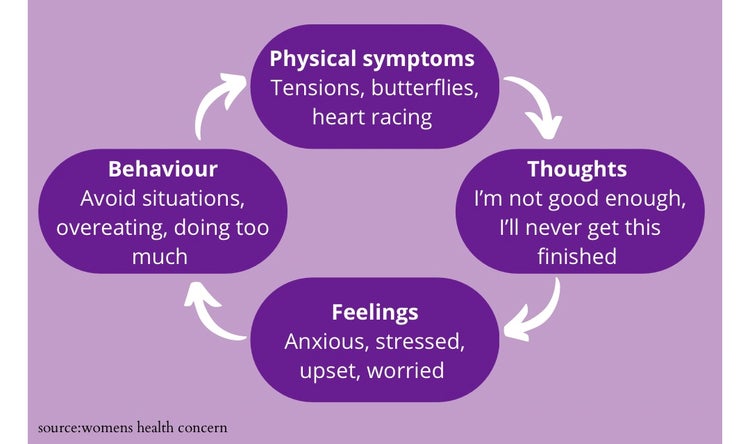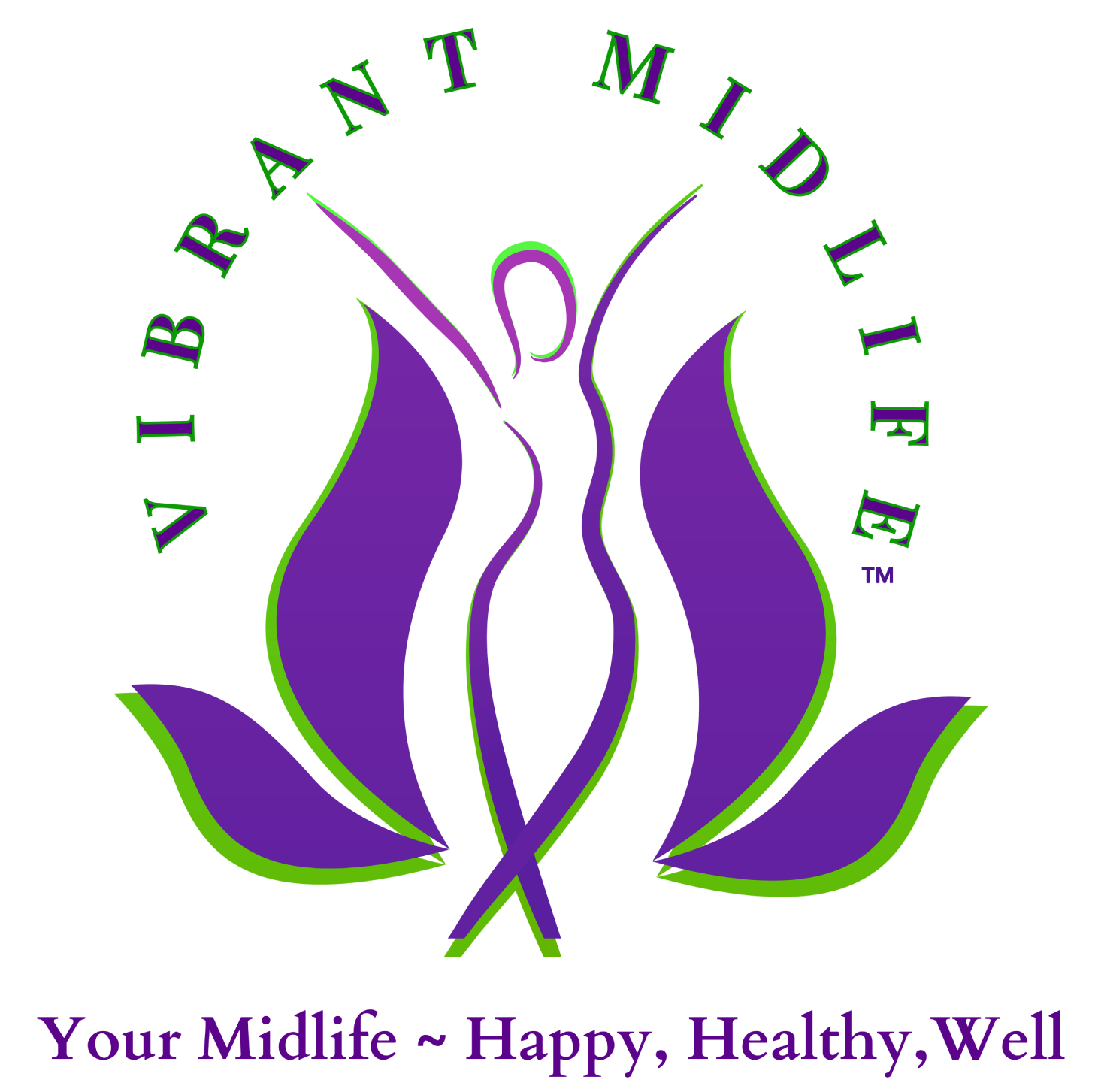Cognitive behavior therapy is a non-medical approach that can help with a variety of health issues such as anxiety and stress, depression, hot flushes and night sweats, sleep problems, and fatigue.
CBT assists people in developing practical problem-solving strategies and provides new coping skills and strategies. As a result, it can be a beneficial approach to try because the skills can be applied to a variety of problems and can improve overall wellbeing.
STRESS AND ANXIETY
Anxiety and stress are common responses to daily life. Stress usually occurs when we are confronted with a situation that appears to be too demanding or overwhelming. Having hot flushes and night sweats can be stressful, and being anxious and stressed can make them worse. Menopause is not necessarily a stressful time, but it occurs in middle age. Anxious thinking, such as expecting the worst possible outcomes, has been identified as an important factor that triggers and maintains anxiety.
With panic attacks, people tend to interpret anxiety symptoms as being signs that they might have a heart attack or faint. Other people might misinterpret normal physical sensations as signs of serious disease and become overly worried about their health. Keeping a diary/journal can help to clarify if they are associated with hot flushes or stressful situations.

Cognitive and Behavioural Strategies for Anxiety and Stress
If you feel anxious or stressed write down your thoughts, feelings and behavioural reactions on the diagram. Anxious/stressful thoughts are not facts but are just one view of a situation. Try to do more of these activities even for just a short time every day. Aim for a balance between rest and activity, and by pacing activities throughout the day.
LOW MOOD
CBT for low mood is helpful for people across the age range and when physical and emotional symptoms occur together. Some women report premenstrual type symptoms, which may be associated with fluctuating hormones. Depressive thinking and behaviour can lead to a cycle of self-criticism and hopelessness. CBT can help people to identify overly negative thoughts so that they can gain a perspective on their concerns.

Cognitive and Behavioural Strategies for Low Mood
Cognitive and behavioural therapy (CBT) helps people overcome self-critical thinking by helping them to look at life from a positive perspective. CBT encourages people to value their own qualities, strengths and competencies. Remember that depressive thoughts are not facts but are just one view of a situation. Small changes such as gradually doing things that you have enjoyed, or new things, can lift mood and improve wellbeing.
NIGHT SWEATS AND HOT FLUSHES
Hot flushes occur when oestrogen levels are changing and adjusting to a lower level during the menopause transition. They can be accompanied by sweating, and palpitations or sometimes shivering, and can cause embarrassment, anxiety, discomfort and sleep disruption. The threshold for flushing also narrows if we are under stress so reducing stress and relaxation is an important part of managing hot flushes. CBT for hot flushes focuses on the links between physical symptoms, thoughts, feelings and behaviour. Try wearing loose fitting clothes made of natural, light fabrics such as cotton.
Remove any heavy, thick down duvets from your bed; placing a towel in your bed can absorb some of the sweat. Some women also use a Chillow Pillow, which remains cool throughout the night.

CBT can help you find ways to reduce negative reactions to hot flushes. For example, when this woman feels the onset of a hot flush, she thinks that everyone is looking at her and that she can't cope. These feelings might then lead to increased tension, palpitations and sweating, which intensify the experience. Learning calmer more neutral responses will help you feel more in control and more able to cope.
Cognitive and behavioural strategies for hot flushes and night sweats
Paced breathing is an important part of the CBT approach for hot flushes. Paced breathing involves focusing on your breathing and accepting that the hot flush will pass. As with any skill it requires regular practice – breathing from your stomach. At the onset of a flush, relax your shoulders and breathe slowly from your abdomen.
Cognitive (thinking) strategies – women’s main types of worries about hot flushes and night sweats tend to be:
- Social embarrassment (especially around men, younger people and at work) –“Everyone’s looking at me” – “I look terrible”.
- Lack of control –“This is out of control”, “I can’t cope with these”, “not again!”
- Worries about disrupted sleep –“I’ll never get back to sleep”, “I’ll feel terrible tomorrow”.
Women with the highest levels of distress in reaction to hot flushes tend to ‘catastrophise’ about the hot flush, i.e. think the worst. They are more self-critical within the situation, especially about their appearance. Notice what goes through your mind when you have a hot flush, so that you can identify your typical thoughts and any overly negative thinking, and write them down.
Next work on developing a calmer self-supporting responses to hot flushes, e.g. “This will pass soon”. Some examples are shown here but try to develop your own:
‘Oh no I can’t cope’ ‘Let’s see how well I can deal with this one, one flush at a time’
‘Everyone is looking at me’ ‘I will notice my flushes more than other people, they may not notice’
‘I am out of control’ ‘There are things I can do to take control’
‘They will go on for ever’ ‘They will gradually reduce over time’
It might help to ask yourself:
Is this though really accurate?
What would a close friend/family member say to me?
What would I say to them if they were having a hot flush in this situation?
What would a self-supportive alternative be?

Using paced breathing at the onset of a flush can give you a moment to pause, and help to switch your attention to breathing rather than the flush. Research studies have found that worrying at night about sleeplesness and its effects on the following day (tiredness, wellbeing and performance) can lead to anxiety which then makes sleep less likely. Maintaining a regular sleep pattern – 'lie-ins' and naps after 3 p.m. eat into sleep the following night. Limiting light in the early evening and in the bedroom helps the brain release chemicals (melatonin) linked to sleep onset. As with hot flushes, take time to notice and manage worrying thoughts – about stress and loss of sleep.
Even if you improve your sleep quality, it is likely that you will still be woken by night sweats. The key to managing night sweats is to use cognitive behavioural strategies to remain calm. Feeling anxious about missed sleep makes it more difficult to get back to sleep. With consistent practice, this should become easier and more effective. Here are some examples of changing ‘catastrophic’ thinking into calmer more helpful thoughts:
‘I won’t be able to function tomorrow’ ‘I have managed before so I know I can cope’
‘I’ll never get a decent night’s sleep again’ ‘This is tough at the moment but will pass’
‘I’ve got so much to do tomorrow!’ ‘I can prioritise what I need to do and a bit of distraction will help me get on with things’
Therapies for hot flushes and night sweats are often referred to as Cognitive Behavioural Therapy (CBT) - or CBT - and can help you feel more in control of your body. Practising paced breathing and making adjustments to your reactions might be all you need to feel more relaxed. CBT is a self-help guide over four weeks that has been shown to be effective in clinical trials, and is available on the NHS.

